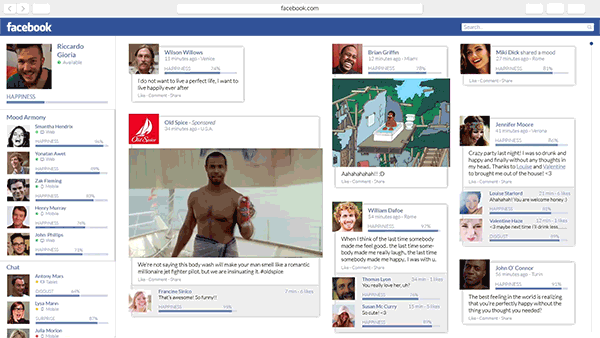
Each one of us has a physical and a virtual identity.
While the first one must necessarily reflect the person, the second one can be imaginary, giving you the chance to create your own digital alter ego as you want.
You can be smarter, stronger, cynical or funnier. You can be whoever you want to.
In a future where social networks will be more and more intrusive in our lives, this difference could be thinner and thinner, until it may almost disappear.
We might have to share, with or without our will, even more personal information and specifications about ourselves, creating a real mirror of us online.
We might have to share, with or without our will, even more personal information and specifications about ourselves, creating a real mirror of us online.

Our project Facemood borns with this premise. We imagined a hypothetical future in which social networks, accessing webcam of our computers, will be able to detect our presence in front of the screen, using facial recognition to log-in and recognize our emotions.
Why the emotions? Because generally they are difficult to disguise, they can make people understand how we feel at that moment and are strictly individual.
In this dystopian world people can not lie about their feelings during the publication of a post or a photograph or in response to a video shared by a friend: thus become virtual mirrors of themselves.


For the user interface we have tried to focus our attention on the key features of our concept, removing anything
that was not strictly characteristic.


After logging in, the social network will detect your emotions in that moment and will change your Profile Picture accordingly: in the same time the Moodbar will show in real time an approximate percentage of the felling intensity.


Mood Armony will refresh to show you the top five friends that in that moment have your same emotion.


The News Feed will refresh whenever the user's mood changes, showing users generated content up to date.


The advertising will be increasingly present and invasive in our experience with the social network.
It will be characterized according to our mood and our post, to be more specialized and effective.
You will have to also watch it until its end to return to the normal site navigation (clearly inspired by the masterpiece of Black Mirror).

We also record a short video to let you understand how these new technologies could be integrated into a real-life situation.
The story is about a guy who has recently been dumped by his girlfriend.
Awoke sad, he access to social networks and scroll the timeline until a comment of a close friend makes him smile again.
After the vision of a video, he reads the comment of his ex-girlfriend that makes him return sad, bringing it back to the previous screen where an advertising focused on his situation appears.
The story is about a guy who has recently been dumped by his girlfriend.
Awoke sad, he access to social networks and scroll the timeline until a comment of a close friend makes him smile again.
After the vision of a video, he reads the comment of his ex-girlfriend that makes him return sad, bringing it back to the previous screen where an advertising focused on his situation appears.


To detect face and its components we used the software FaceOSC, written and shared by Kyle McDonald and based on ofxFaceTracker, an addon for openFrameworks face tracking, based on Jason Saragih's FaceTracker library.
FaceOSC allows us to send to an external software the data that it detects from the triangulation of a face, such as the width of the mouth or eyes position in three dimensions.
FaceOSC allows us to send to an external software the data that it detects from the triangulation of a face, such as the width of the mouth or eyes position in three dimensions.

To prototype our project we used Processing, that receiving data from FaceOSC through OSC, has allowed us to analyze them to detect emotions.
Here there's a short video that explain how FaceOSC interact with our processing sketch.











